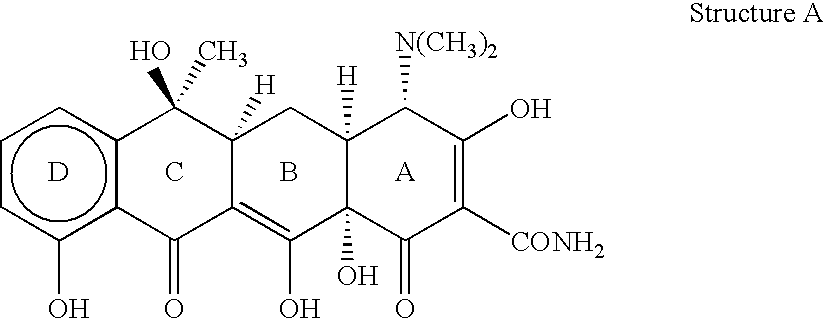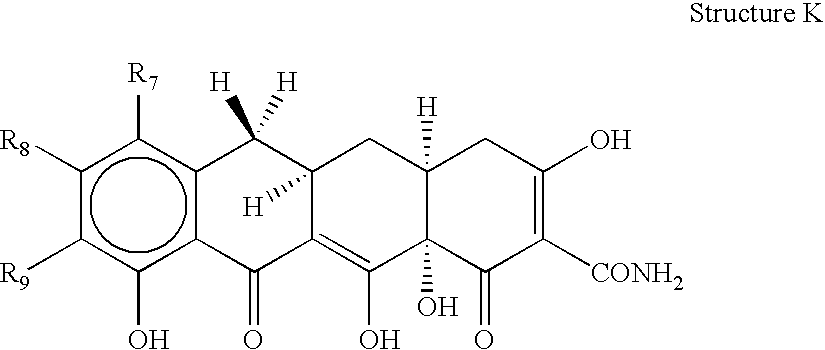Use of non-antibacterial tetracycline formulations for inhibiting bacterial spores
a technology of tetracycline and formulation, which is applied in the direction of tetracycline active ingredients, antibacterial agents, biocide, etc., can solve the problems of synthetic tetracyclines with substantially less or effective antimicrobial activity, and achieve the effect of inhibiting the outgrowth of bacterial spores
- Summary
- Abstract
- Description
- Claims
- Application Information
AI Technical Summary
Benefits of technology
Problems solved by technology
Method used
Image
Examples
example 1
Germination of Bacillus cereus ATCC 10987
[0081]Bacillus cereus ATCC 10987 was grown in CCY medium (Stewart et al., Biochem. J. 198:101-106, 1981) and the spores were prepared as outlined by Clements and Moir (J. Bacteriol., 180:6729-6735, 1998). Phase-contrast microscopy showed the spore preparation to consist of bright refractive bodies. Further tests indicated that greater than 95% of the spores were resistant to heating at 70° C. for one hour.
[0082] Bacterial spores have “germination receptors” which bind germinants (such as inosine). The binding of the germinant to receptor initiates spore early germination. Early germination takes place without active metabolism.
[0083] Spore germination was assayed in the presence (open squares) and absence (closed diamonds) of 5 ug / ml COL-3. Spores were suspended in 10 mM Tris-HCl (pH 8.0) to an OD at 580 nm of 1.00, and the suspension was incubated for 15 min. at 37° C.
[0084] Germination was initiated with 5 mM inosine and the optical den...
example 2
Gram-Stain Observation of Germination in the Presence and Absence of COL-3
[0087] Five ml of spores (approximately 5×107CFU per ml), suspended in 10 mM Tris-HCl (pH 8), were placed into two test tubes and warmed to 37° C. To one tube, COL-3 was added to a final concentration of 5 μg per ml. The other tube received an equal volume of dimethylsulfoxide (DMSO) vehicle alone. At time=zero, 1.5 ml of pre-warmed Brain Heart Infusion Broth was added to each tube and the tubes were vortexed for 10 seconds. The tubes were then placed back into a 37° C. heating block.
[0088] Starting at time=0, 0.5 mls were withdrawn at 10 min. intervals and placed into 0.5 ml of 5% formaldehyde-phosphate buffered saline and chilled on ice. At the completion of the experiment, all samples were centrifuged at 10×g for 5 min. and the supernatant discarded.
[0089] The pellets were resuspended in 0.1 ml phosphate buffered saline. These samples were allowed to dry on glass microscope plates and then Gram-stained. ...
PUM
 Login to View More
Login to View More Abstract
Description
Claims
Application Information
 Login to View More
Login to View More - R&D
- Intellectual Property
- Life Sciences
- Materials
- Tech Scout
- Unparalleled Data Quality
- Higher Quality Content
- 60% Fewer Hallucinations
Browse by: Latest US Patents, China's latest patents, Technical Efficacy Thesaurus, Application Domain, Technology Topic, Popular Technical Reports.
© 2025 PatSnap. All rights reserved.Legal|Privacy policy|Modern Slavery Act Transparency Statement|Sitemap|About US| Contact US: help@patsnap.com



